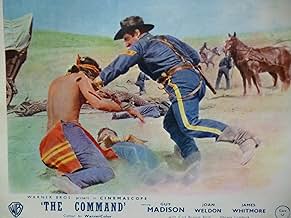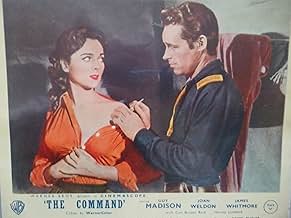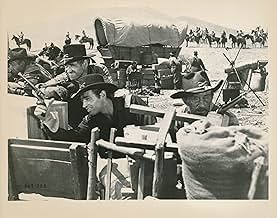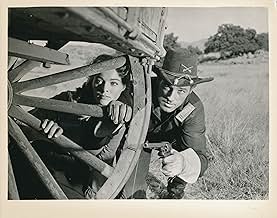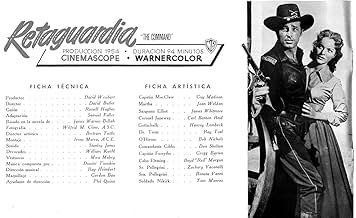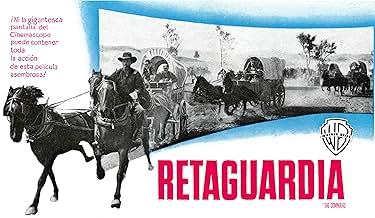AVALIAÇÃO DA IMDb
6,4/10
706
SUA AVALIAÇÃO
Adicionar um enredo no seu idiomaAn Army doctor with no combat experience is forced to take command of a cavalry troop escorting a wagon train through hostile Indian country when the unit's commanding officer dies.An Army doctor with no combat experience is forced to take command of a cavalry troop escorting a wagon train through hostile Indian country when the unit's commanding officer dies.An Army doctor with no combat experience is forced to take command of a cavalry troop escorting a wagon train through hostile Indian country when the unit's commanding officer dies.
- Direção
- Roteiristas
- Artistas
Robert Nichols
- 2nd Lt. O'Hirons
- (as Bob Nichols)
Carl Andre
- Trooper
- (não creditado)
Emile Avery
- Outrider
- (não creditado)
Jim Bannon
- Infantryman
- (não creditado)
Gregg Barton
- Capt. Forsythe
- (não creditado)
George Bell
- Webb
- (não creditado)
John Beradino
- Sergeant Major
- (não creditado)
Richard Boyer
- Infantry Sergeant
- (não creditado)
Larry Chance
- Indian Brave
- (não creditado)
Mack Chandler
- Infantry Lieutenant
- (não creditado)
- Direção
- Roteiristas
- Elenco e equipe completos
- Produção, bilheteria e muito mais no IMDbPro
Avaliações em destaque
A great Western that entertains well. It is a movie, along with "Charge at Feather River", where Guy Madison plays a character that though having to fight the Indians, also understands their situation.
The chemistry between Madison's and Whitmore's characters was very well played. It is well paced with story moments and action moments fitting together well.
As a historical note, the Winchesters used by the troopers were incorrect as props but then this was a 1950s Western when no one cared about those details. Spencer Carbines would have been correct but unavailable. The one interesting gun prop is in the scene where the scouts are chased back to the column and meet up with the Capt. and others. One of the troopers is obviously holding a Schofield revolver which though quite unusual, were used by the U.S. Cavalry in small numbers.
I really hope that this movie is released on DVD someday soon.
The chemistry between Madison's and Whitmore's characters was very well played. It is well paced with story moments and action moments fitting together well.
As a historical note, the Winchesters used by the troopers were incorrect as props but then this was a 1950s Western when no one cared about those details. Spencer Carbines would have been correct but unavailable. The one interesting gun prop is in the scene where the scouts are chased back to the column and meet up with the Capt. and others. One of the troopers is obviously holding a Schofield revolver which though quite unusual, were used by the U.S. Cavalry in small numbers.
I really hope that this movie is released on DVD someday soon.
This is a very good story that was made into a very compelling western by director David Butler from James Warner Bellah's novel "rear guard". Samule Fuller and Russell S. Hughes get credit for the tau and only occasionally glossy screenplay. Star Guy Madion made several estimable and well-remembered westerns in the 1950s, in which decade he also starred in the "Wild Bill Hickick" TV series along with Andy Devine. The intriguing part of this standard story-line which concerns a ranking officer having to assume leadership of a cavalry outfit after the death of its senior officer is that this man happens to be a medical Captain, not a field commander. They fall in with a wagon train during Indian troubles, and end up meeting infantry as well, whom his second, powerfully played by James Whitmore, refers to as "stinkin' beetle crushers". Madson assumes command of both groups, romances lovely and talented Joan Weldon, and nurses the wagon train through sickness and danger; then, at the last, he gets the inspiration to mount cannon onto the wagons, form a hollow square, and draw the Indians into an ambush. Thus, he uses his imagination to defeat the Indian's long-delayed final attack. Madison gets Weldon, Whitmore's honor as a cavalrymen is served, and all ends well; but there are good dialogue confrontations and strong situations along the way, plenty of battle action and unusually strong character revelations. Music was supplied for this film by veteran Dimitri Tiomkin, costumes by Moss Mabry. The fine cinematography was the work of Wilfrid M. Cline. In the professional cast along with Madison, Whitmore and Weldon were Carl Benton Reid, Harvey Lembeck, Ray Teal, Robert Nichols, Gregg Barton, Renata Vanni, Zacharias Yaconelli, Jim Bannon and others. This is a quality production and a very strong story line which has to do with being true to values as its general themes. It is exceptionally well- carried-out, I suggest and thoughtful, not just for a western but for any genre of film.
This is one of those old Cowboy versus Indian westerns. As a kid growing up the cowboys were the good guys and the Indians the bad guys. Obviously as you grow up you realise that this wasn't the case. As a result the sight of Native Americans being mown down, leaves me slightly peeved. However I did watch the film in the context of the time it was made.
Although it does drag in parts towards the middle, in the main this is a very well made western with some great action scenes as the cavalry do battle with the Indians. The final battle scenes were excellently done. Guy Madison does a good job as the charismatic doctor finding himself in charge of a troop when the commanding officer is killed. There is a bit of humour thrown in now and again and of course the the obligatory romance with the love interest being played by the beautiful Joan Weldon.
Although not a truly great Western it's certainly an above average one and well worth watching for fans of this genre.
Although it does drag in parts towards the middle, in the main this is a very well made western with some great action scenes as the cavalry do battle with the Indians. The final battle scenes were excellently done. Guy Madison does a good job as the charismatic doctor finding himself in charge of a troop when the commanding officer is killed. There is a bit of humour thrown in now and again and of course the the obligatory romance with the love interest being played by the beautiful Joan Weldon.
Although not a truly great Western it's certainly an above average one and well worth watching for fans of this genre.
When the unit's commanding officer dies , an unexperienced officer doctor (Guy Madison) takes the command a regiment and to lead a wagon train through hostile Indian country . But the Privates believe that experienced Sgt. Elliott (James Withmore) should have been put in temporary command until they reach the Fort . Then , they are ordered by the Colonel in command of a group of infantry to escort a wagon train of settlers (Joan Weldon , among them) moving west . Along the way they must fight off illness , smallpox and rampaging Comanches who are also after them . The Story of the Unconquerable!
Moving and action-packed Western with a simple , standard story that engages the viewer until the last scene , dealing with a cavalry troop escorting a wagon train . An ordinary Cavalry Western in which a officer doctor is saddled with the risked assignment of steering a wagon train through hostile Indian territory . The film packs thrills , noisy action , crossfire , and being enough entertaining . It's a medium budget film with comfortable actors , technicians , functional production values and pleasing results . This was the first Cinemascope Western and the first Scope movie of any kind from Warner Brothers , a studio formerly committed to the 3D process , and not forgetting the Panoramic shots that showed the new process off to its best effect , using Zeiss anamorphic lenses . Decent and pleasant traditional Western with professional direction and flawlessly acted by Guy Madison as Capt. Robert MacClaw , Joan Weldon as Martha Cutting and James Whitmore as Sgt. Elliott . Guy Madison was one of the most popular Western stars at the time , he also performed in the first 3D Western : The charge of Feather River . Guy played leads in a series of programmers before being cast as legendary lawman Wild Bill Hickok in the TV series Adventures of Wild Bill Hickok (1951). Madison had his first major role in "Until the End of Time" a drama directed by Edward Dmytryk, 1946 to then changed in action roles , mainly series B westerns , get some successes with the series . He played Hickok on TV and radio for much of the 1950s, and many of the TV episodes were strung together and released as feature films. Madison managed to squeeze in some more adult-oriented roles during his off-time from the series, but much of this work was also in westerns. After the Hickok series ended Madison found work scarce in the U.S. and traveled to Europe, where he became a popular star of Italian westerns and German adventure films , such as : ¨Duel at Rio Bravo¨ , ¨7 Winchester for a massacre¨ , ¨Bang bang Kid¨, ¨Five for revenge¨ , ¨Il figlio di Django¨ and ¨Reverend Colt¨ . Support cast is pretty well, giving splendidly fortright acting , such as : Carl Benton Reid , Gregg Barton , Harvey Lembeck , Denver Pyle and usual Ray Teal , among others .
It contains an atmospheric and adequate musical score by the classic composer Dimitri Tiomkin . Faded and tarnished cinematography Wilfrid M. Cline with a very bad print , being utterly necessary a perfect remasterizing . Being shot on location in Russell Ranch - Triunfo Canyon Road , Janss Conejo Ranch, Thousand Oaks, Agoura, California, and Warner Ranch, Calabasas, California. This breeze-fresh movie filled with get-up-and-go was professionally directed by David Butler, though drags at times , balancing in ups and downs . Butler was a good craftsman who directed all kinds of genres with special penchant for comedy , musical and drama . As he directed : April in Paris , Tea for two , Playmates , Doubting Thomas , Caught in the draft , The story of Seabiscuit , Lullaby in Broadway , The princess and the pirate , Captain January , The road to Morocco , and Westerns as : San Antonio , Calamity Jane and this The Command . Rating : 5.5/10 . Acceptable and passable .
Moving and action-packed Western with a simple , standard story that engages the viewer until the last scene , dealing with a cavalry troop escorting a wagon train . An ordinary Cavalry Western in which a officer doctor is saddled with the risked assignment of steering a wagon train through hostile Indian territory . The film packs thrills , noisy action , crossfire , and being enough entertaining . It's a medium budget film with comfortable actors , technicians , functional production values and pleasing results . This was the first Cinemascope Western and the first Scope movie of any kind from Warner Brothers , a studio formerly committed to the 3D process , and not forgetting the Panoramic shots that showed the new process off to its best effect , using Zeiss anamorphic lenses . Decent and pleasant traditional Western with professional direction and flawlessly acted by Guy Madison as Capt. Robert MacClaw , Joan Weldon as Martha Cutting and James Whitmore as Sgt. Elliott . Guy Madison was one of the most popular Western stars at the time , he also performed in the first 3D Western : The charge of Feather River . Guy played leads in a series of programmers before being cast as legendary lawman Wild Bill Hickok in the TV series Adventures of Wild Bill Hickok (1951). Madison had his first major role in "Until the End of Time" a drama directed by Edward Dmytryk, 1946 to then changed in action roles , mainly series B westerns , get some successes with the series . He played Hickok on TV and radio for much of the 1950s, and many of the TV episodes were strung together and released as feature films. Madison managed to squeeze in some more adult-oriented roles during his off-time from the series, but much of this work was also in westerns. After the Hickok series ended Madison found work scarce in the U.S. and traveled to Europe, where he became a popular star of Italian westerns and German adventure films , such as : ¨Duel at Rio Bravo¨ , ¨7 Winchester for a massacre¨ , ¨Bang bang Kid¨, ¨Five for revenge¨ , ¨Il figlio di Django¨ and ¨Reverend Colt¨ . Support cast is pretty well, giving splendidly fortright acting , such as : Carl Benton Reid , Gregg Barton , Harvey Lembeck , Denver Pyle and usual Ray Teal , among others .
It contains an atmospheric and adequate musical score by the classic composer Dimitri Tiomkin . Faded and tarnished cinematography Wilfrid M. Cline with a very bad print , being utterly necessary a perfect remasterizing . Being shot on location in Russell Ranch - Triunfo Canyon Road , Janss Conejo Ranch, Thousand Oaks, Agoura, California, and Warner Ranch, Calabasas, California. This breeze-fresh movie filled with get-up-and-go was professionally directed by David Butler, though drags at times , balancing in ups and downs . Butler was a good craftsman who directed all kinds of genres with special penchant for comedy , musical and drama . As he directed : April in Paris , Tea for two , Playmates , Doubting Thomas , Caught in the draft , The story of Seabiscuit , Lullaby in Broadway , The princess and the pirate , Captain January , The road to Morocco , and Westerns as : San Antonio , Calamity Jane and this The Command . Rating : 5.5/10 . Acceptable and passable .
10segstef
The good thing about this movie is the sympathy toward Native Americans. The Native Americans had no immunity to smallpox or chicken pox and no medicine to treat diseases. The main character played by Guy Madison constantly showed concern toward the Native Americans although he had to fight them. Although this movie had this social issue,it still had all the rousing entertainment of most calvary movies. The movie had a lot of saluting, which sometimes became a distraction. James Whitmore was great as the seasoned veteran just as he was in "Battleground". This movie had me wanting both sides to win.
Você sabia?
- CuriosidadesAt about 79 minutes, in a scene of Indians attacking the wagons full of soldiers, one Indian gets shot off his horse, then is run over by a wagon drawn by four horses . That wasn't a planned stunt--he was supposed to be "shot" and fall off the side of his horse, but the horse unexpectedly reared back and dumped him into the path of the wagon, which ran over him. He suffered numerous broken bones and ribs, but the scene was left in.
- Erros de gravaçãoIn 1876 the single-shot Springfield Model 45-70 1873 rifle was the standard US Army infantry rifle, as identified by Captain MacClaw when he picks up an abandoned one. The cavalry used a single-shot carbine version of the Springfield 1873. Yet the final battle sequences show both the infantry and the cavalry troopers exclusively using Winchester or Henry style lever action repeating rifles, even though these weapons were never Army issue.
- Citações
Sgt. Elliott: Never say an Injun is dumb. He just waits for the chance to use his one good cavalry tactic: ring around and close in.
- ConexõesReferenced in Com o Céu no Coração (1954)
Principais escolhas
Faça login para avaliar e ver a lista de recomendações personalizadas
- How long is The Command?Fornecido pela Alexa
Detalhes
- Data de lançamento
- País de origem
- Idiomas
- Também conhecido como
- Retaguardia
- Locações de filme
- Empresa de produção
- Consulte mais créditos da empresa na IMDbPro
Bilheteria
- Faturamento bruto nos EUA e Canadá
- US$ 2.500.000
- Tempo de duração
- 1 h 34 min(94 min)
Contribua para esta página
Sugerir uma alteração ou adicionar conteúdo ausente

